
The Dolomites, also known as the Dolomite Mountains, Dolomite Alps or Dolomitic Alps, are a mountain range in northeastern Italy. They form part of the Southern Limestone Alps and extend from the River Adige in the west to the Piave Valley in the east. The northern and southern borders are defined by the Puster Valley and the Sugana Valley. The Dolomites are in the regions of Veneto, Trentino-Alto Adige/Südtirol and Friuli-Venezia Giulia, covering an area shared between the provinces of Belluno, Vicenza, Verona, Trentino, South Tyrol, Udine and Pordenone.
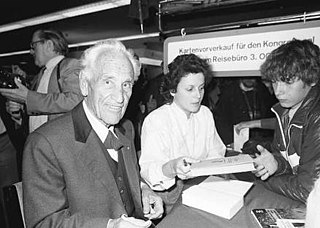
Luis Trenker was a South Tyrolean film producer, director, writer, actor, architect, alpinist, and bobsledder.

Riva del Garda is a town and comune in the northern Italian province of Trento of the Trentino Alto Adige region. It is also known simply as Riva and is located at the northern tip of Lake Garda.
Marianne Hold was a German movie actress who became popular in the 1950s and 1960s for her numerous roles in the Heimatfilm genre—romantic comedy films set in rural, especially Alpine, areas. She served as the inspiration for the female characters created by manga artist Leiji Matsumoto.

Urtijëi is a town of 4,637 inhabitants in South Tyrol in northern Italy. It occupies the Val Gardena within the Dolomites, a mountain chain that is part of the Alps.
Nago–Torbole is a comune (municipality) in Trentino in the northern Italian region Trentino-Alto Adige/Südtirol, located about 30 kilometres southwest of Trento on the north shore of Lake Garda.

Der Kaiser von Kalifornien, is a 1936 film that was the first Western film made in Nazi Germany. Some exterior scenes were shot on location in the United States at Sedona, Arizona, the Grand Canyon, and Death Valley in California.

Alarm Bells is a 1949 Italian drama film directed by Luigi Zampa and starring Gina Lollobrigida, Yvonne Sanson and Eduardo De Filippo.

Tofane is a mountain group in the Dolomites of northern Italy, west of Cortina d'Ampezzo in the province of Belluno, Veneto. Most of the Tofane lie within the Ampezzo Dolomites Natural Park.
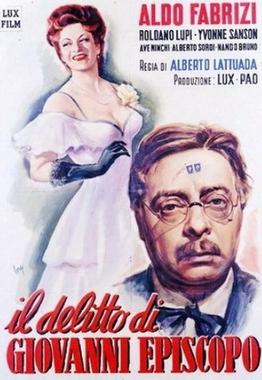
Flesh Will Surrender is a 1947 Italian drama film directed by Alberto Lattuada. It is based on the novel Giovanni Episcopo by Gabriele D'Annunzio. It was entered into the 1947 Cannes Film Festival.

Yvonne Sanson was an Italian film actress. She appeared in 46 films between 1946 and 1972, mainly working in Italy. Born in Salonica, Sanson was a naturalised Italian citizen and was maternally of Turkish origin and paternally of French-Russian origin.
The Mountain Calls is a film directed by Luis Trenker which recreates the struggle between Edward Whymper and Jean-Antoine Carrel for the first successful ascent of the Matterhorn in 1865.

Angelo Dibona was an Austro-Hungarian and Italian mountaineer. He is remembered as one of the great pioneers of climbing in the Dolomites and is responsible for many first ascents throughout the Alps. The Aiguille Dibona in France, the Campanile Dibona and the Dibona-Kante on the Cima Grande di Lavaredo are named after him.
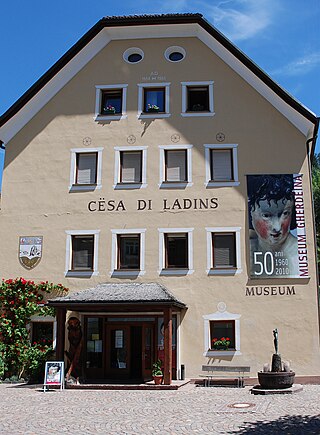
The Gherdëina Local Heritage Museum was opened in the Cësa di Ladins in Urtijëi, in northernmost Italy, in 1960. The building is the seat of the Union di Ladins de Gherdëina a cultural organisation for the keeping of the Ladin language and heritage in Val Gherdëina. In addition to the museum, the building hosts a library specialized in Ladin language and culture.

The Great Leap is a 1927 German silent comedy film directed by Arnold Fanck and starring Leni Riefenstahl, Luis Trenker and Hans Schneeberger. A young Italian girl living in the Dolomites falls in love with a member of a tourist party skiing on the nearby mountains.

Mountains on Fire is a 1931 German war film directed by Karl Hartl and Luis Trenker and starring Trenker, Lissy Arna and Luigi Serventi. The film was based on Luis Trenker's novel of the same title, partly based on his own experiences. Separate French and English-language productions were also made.

Josef “Sepp” Allgeier was a German cinematographer who worked on around fifty features, documentaries and short films. He began his career as a cameraman in 1911 for the Expreß Film Co. of Freiburg im Breisgau. In 1913, he filmed newsreels in the Balkans. He then became an assistant to Arnold Fanck, a leading director of Mountain films. He worked frequently with Luis Trenker and Leni Riefenstahl, both closely associated with the genre. He was Riefenstahl's lead cameraman on her 1935 propaganda film Triumph of the Will. During the Second World War, Allgeier filmed material for newsreels. He later worked in West German television. His son is the cinematographer Hans-Jörg Allgeier.
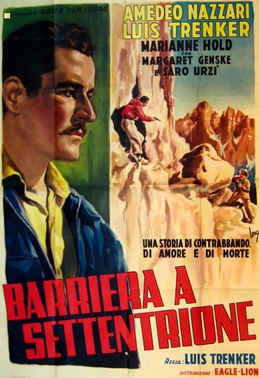
Barrier to the North is a 1950 Italian mountain film directed by and starring Luis Trenker. It also stars Amedeo Nazzari, Marianne Hold and Margarete Genske. It is sometimes known by the alternative title of Mountain Smugglers.
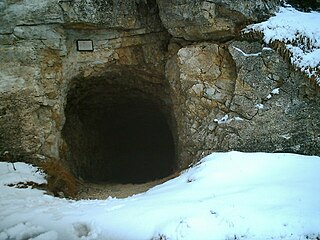
The mines on the Italian front during the First World War comprised a series of underground explosive charges of varying sizes, secretly planted between 1916 and 1918 by Austro-Hungarian and Italian tunneling units beneath their enemy's lines along the Italian front in the Dolomite section of the Alps.

When the Alpine Roses Bloom is a 1955 West German drama film directed by Richard Häussler and Hans Deppe and starring Hertha Feiler, Claus Holm, and Marianne Hold. Along with As Long as the Roses Bloom, it was one of two follow-ups directed by Deppe to his hit 1953 heimatfilm When the White Lilacs Bloom Again.

















